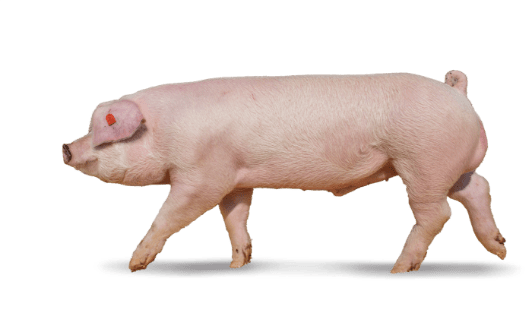
Our 70 year history
Rattlerow have been at the forefront of breeding pigs in the UK for over 70 years and continue to grow and develop to help our customers business grow and develop.



1950s
Rattlerow Farms started its breeding business with a handful of pedigree Large White and Landrace pigs. Now, 70 years on, it’s a £multi-million turnover business with a relentless motivation to innovate, further improve pig performance and continue to to expand.
Growth has come from investment, purchasing new farms to complement its existing operations and maintaining a broad base to its core activities. With significant arable, construction, feed milling, transport, and housing enterprises, and more recently the addition of renewable energy enteprises, Rattlerow is a very different business than the one Philip Lawson started more than six decades ago.


1954
A train to Norwich, a bicycle ride to Stradbroke to buy a farm, and a night locked out for being home late was Philip’s first step into farming. The one-time bomber pilot, and Oxford scholar, was fascinated with breeding and genetics and believed agriculture could satisfy his passion. It might also make a difference to livestock production in post war Britain. He was right and what he established has evolved into something significant that has contributed more to the UK pig sector than just high health, high performance breeding stock.


1960s
A keen eye, AI and consistent uniformity
Philip’s keen eye for conformation, combined with his zealous skill for selecting only the very best performing animals, produced exceptional results. The benefits of AI were also explored and in 1960 the business was one of the first to regularly use it. Philip could see the potential of introducing new lines without health concerns and also the benefits AI offered to produce more litters from high indexed boars. Nowadays, AI is a major part of the Rattlerow business.
It has five studs, the newest being Long Meadow in Cambridgeshire that was completed in 2011 and expanded in 2018. This £1m investment has the potential to house 160 boars and with its air conditioning and filtration systems, means it is one of Europe’s most technically advanced facilities.


1970s
During the 1970s, Rattlerow joined the Meat and Livestock Commission’s competitive pig performance testing scheme. It produced unbiased and accurate test results that customers could use with confidence to purchase high pointed boars or semen. For six out of 10 years MLC results demonstrated that Rattlerow stock was ahead of its competition for economic lean meat production and this helped to drive sales.
Back then prospective customers were not just pig farmers; they also came from a ‘new-generation’ of breeding companies focused on high health and hybridisation.
“We actually supplied seed stock to many of those new breeding companies, some of which are now our competitors. Many of their foundations were laid with Rattlerow genes, so we have played a part in their developments,” says Robert.


2000s
In 2002 genetic development gathered pace when Rattlerow purchased a major share in SEGHERSgenetics and SEGHERSgentec, and a new company, Rattlerow Seghers was formed.
This investment increased access to DNA technology and molecular research resources and in 2004, the company’s 50th year, it produced three new terminal boars, MaxiMus , OptiMus and MaxiLean. These sires carried a newly discovered gene marker, BETTERgen muscle+.
This patented DNA marker explained 25% of the variation in muscle mass and fat deposition, without effecting growth or meat eating quality.
These sires also offered customers new, robust boar lines that proved more capable of better withstanding the challenge of PMWS, which at that time was the production sectors biggest challenge.
Acquiring the Seghers business also brought new export opportunities across Europe and Asia with China being one of the most interesting. Rattlerow Seghers is a majority partner in a Chinese nucleus operation in Hebei province.


The present
SOWING SEEDS AND GOING GREEN
When Adrian and Robert Lawson joined the business in the mid 1980’s Rattlerow farmed 600 acres and had 600 sows. Adrian, who is also Joint Managing Director, says that by consistently working hard and reinvesting, the business managed to regularly purchase new farms to complement its existing operations.
“In addition to our main focus on pig breeding, we have kept a broad base to our business and have significant arable, construction, feed milling, transport, and housing enterprises. More recently, renewable energy has been added to our activities, but all of our enterprises are symbiotic to the pig business,” he adds.
During difficult years this diversity has been valuable, Adrian says, “When one is sector is challenged, then another is usually performing well. There is balance and that benefits the whole,” he adds.
Today Rattlerow farms more than 60 pig sites and has 3000 acres of intensive arable land. Every farm operates on an individual cost base and is run with its own team. None of the farms are ‘mega units’, so have avoided many of the issues associated with larger production sites.
But none of this growth would have been possible without the full support of an expanding, experienced and dedicated team. “We have been extremely lucky to attract and keep our staff, even through the difficult times,” says Robert.
The company carefully manages its initial selection process, has an active training programme and works hard to make staff feel valued and an important part of the business.
“Where possible we promote from within and aim to delegate significant responsibilities to key members of the team,” he adds.



Outdoor demands & an easy approach
Consumerism has created new pressures for livestock farmers with welfare, organic and environmentally friendly becoming ideals. During the 1990s outdoor pig production seemed to fit the model.
Rattlerow initially gained its reputation in this market ten years earlier by adapting its boar accommodation and the procedures it used to ‘harden off groups’ of Large White boars. These principles ensured working boars met customer specifications and they were ready for life outside. Large numbers of boars were sold to work in groups of 4 to 8, as back then outdoor production relied on this natural group mating or ‘gang bang’ system.


The development of the LandRoc gilt came in 1992 and her pure white line inheritance, combined with just enough Duroc genetics, made her prolific, yet robust enough to perform well in a tough outdoor environment.
In 1996, manager Ken Mackenzie was presented with a number of national production awards for outstanding performance from a 250-sow Landroc-based herd. He was producing more than 26 pigs per sow for a BQP operation and increased productivity to 27 pigs reared per sow in 1997. The Whiteroc was launched in 2001, and together from humble beginnings these dam lines are now used by many of the UK’s leading outdoor pig producers. They are quite possibly the UK’s most popular outdoor gilts.
Other advances for outdoor production included the development of a ‘service pod’. Designed and produced with key customer Easey Pigs and BPEX, the pod drew on Rattlerow’s own experience with outdoor AI and helped to lift sow productivity in outdoor herds.


Balanced breeding
Genetically, Rattlerow also strives to make managing their genotypes as simple as possible and an ‘Easy-2-Manage’ strategy is incorporated in its breeding programme. This ‘holistic’ approach to selection embraces production experience and although the main focus remains on key traits, such as prolificacy and fertility for dam lines and fast, lean growth for terminal sires, other characteristics are also incorporated. For example, dam lines are continually assessed for mothering ability, lactation and temperament. It’s the whole reproductive package and that aids management at commercial level, as is clearly evident on their own herds and customer farms.
“Customers say our stock is well tempered and easy to manage. Aggression is something we have never really encountered, but it seems to be a growing problem with certain lines. Tail biting is another issue that rarely seems to affect our genotypes. Maybe our pure-line breeding programme and consistent selection process over many years has something to do with this,” Robert comments.
Bespoke innovation
So what next for this progressive, innovative family firm with an inherent passion for pigs? Well more of the same, but with a more bespoke approach, says Simon Guise, Sales Manager.
“What we want to do now is apply what we know about production to our customers individual breeding programmes. The aim is to create a bespoke genetics service, tuned to their specific business needs and objectives so we can help them to achieve their production targets and more,” he adds.
Agreements with key integrators are built on this strategy. Rattlerow works closely with its customers to simplify their genetic input so that they can concentrate their efforts on their commercial production and growing their businesses.
Philip Lawson’s passion to improve growth and efficiency is how Rattlerow Farms began. Its continued growth – be that in its high-performing stock or as an expanding British-based agricultural company – will continue to benefit its customers and the UK pig sector for many years to come.




